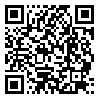Volume 4, Issue 2 (April 2020)
AOH 2020, 4(2): 557-562 |
Back to browse issues page
Download citation:
BibTeX | RIS | EndNote | Medlars | ProCite | Reference Manager | RefWorks
Send citation to:



BibTeX | RIS | EndNote | Medlars | ProCite | Reference Manager | RefWorks
Send citation to:
Etemadinezhad S, Zafarian L, Yazdani Charati J, Ahmadi M. Investigating Work-Family Conflict Status and Its Relationship with Teachers’ Demographic Features of Shahrekord: Cross-Sectional Study. AOH 2020; 4 (2) :557-562
URL: http://aoh.ssu.ac.ir/article-1-149-en.html
URL: http://aoh.ssu.ac.ir/article-1-149-en.html
1- Associate professor, department of occupational health engineering and ergonomics, School of Health Sciences, Mazandaran University of Medical Sciences, Sari, Iran
2- MSc of Occupational Hygiene, department of occupational health engineering and ergonomics, school of health sciences, Mazandaran University of Medical Sciences, Sari, Iran
3- Associate professor, department of Biostatistics, School of Health Sciences, Mazandaran University of Medical Sciences, Sari, Iran
4- MSc of ergonomics, department of occupational health engineering and ergonomics, school of health sciences, Mazandaran University of Medical Sciences, Sari, Iran
2- MSc of Occupational Hygiene, department of occupational health engineering and ergonomics, school of health sciences, Mazandaran University of Medical Sciences, Sari, Iran
3- Associate professor, department of Biostatistics, School of Health Sciences, Mazandaran University of Medical Sciences, Sari, Iran
4- MSc of ergonomics, department of occupational health engineering and ergonomics, school of health sciences, Mazandaran University of Medical Sciences, Sari, Iran
Abstract: (2115 Views)
Background: increasing the number of families with employed men and women leads to changes in families' structure during recent years that these structural changes have disrupted family and work-life balance and have caused family-work conflict. Work-family conflict is an inter-role conflict that has been created due to incompatible pressures in work and family domains. Therefore, the present study aims at investigating work-family conflict among the teachers' population of Shahrekord and its relationship with demographic features. Methods: the present study is descriptive-analytical research, which has been conducted among 346 teachers in Shahrekord in 2019. Carlson Work-Family Conflict Questionnaire used to measure work-family conflict in this study. SPSS v22 has analyzed collected data through Pearson correlation statistical tests, independent t-test, variance analysis, and multivariate analysis of variance. Results: there is a statistically meaningful relationship between conflict parameters (time, pressure, and behavior) and general conflict (P < 0.01). Time parameter has a more meaningful relationship with public conflict; also, there is no statistically significant relationship between demographic parameters of age, work experience, and income in different levels of conflict (P > 0.05). Conclusion: generally, the current study revealed that Shahrekord teachers had experienced work-family conflict, in which the main problem was related to the work-family conflict in a way that occupational status intervenes in family life. Also, the time factor has the most effect on the incidence of conflict that is the time which has to be assigned to a work or family field, intervenes in the necessary time for another domain. There was no meaningful relationship between work-family conflict and parameters of age, gender, marital status, work experience, and income, which have been considered in this study.
Type of Study: Research |
Subject:
Special
Received: 2019/01/8 | Accepted: 2020/04/8 | Published: 2020/04/8
Received: 2019/01/8 | Accepted: 2020/04/8 | Published: 2020/04/8
| Rights and permissions | |
 |
This work is licensed under a Creative Commons Attribution-NonCommercial 4.0 International License. |







